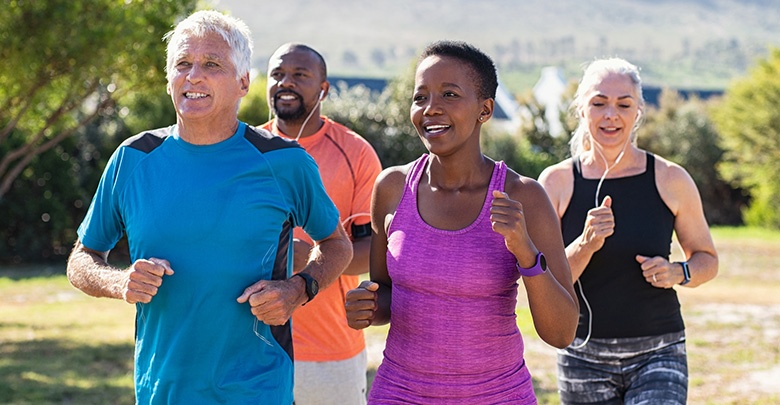
Would you like to know more about yoga with arthritis? Or some other form of sport or exercise which you can still enjoy and benefit from even if you have arthritis?
For active sports lovers, a diagnosis of osteoarthritis (OA) may seem like a life altering curse, requiring them to give up the sport they love. However, nothing could be further from the truth. In fact, sport has been proven beneficial in so many ways, and most importantly sport contributes to reducing pain, depression and the progression of the disease.
USE the OMH exclusive code "HEALTH15" to Save 15%First of all, it is crucially important to discuss your choice of sport with your orthopaedic surgeon or with your physiotherapist in order to align your overall therapy with your sporting activities and training. Secondly, almost all of the most popular sports have a “lower impact” option of competitive levels which are available to, or even recommended for osteoarthritis patients, and which can be as much fun as the “full impact” version.
We recommend that you slightly modify the sports you love, or that choose fun alternatives!
We have some ideas for you, so do keep reading…
But first let’s get started with the WHY?
Why do you need to modify your sport?
High impact sports negatively affect your hip and knee joints in particular, possibly resulting in micro-injuries, discomfort and pain for OA sufferers.
When the cartilage – which has an important protective role for the bones – wears down and fragments, the corresponding bone ends of the joints are more exposed. In the initial stages this results in irritation of the joint. Later it results in inflammation which will cause pain as well as damage to the entire joint. The more impactful the sport is – for example soccer, rugby or running on hard surface, etc. – the faster this process of wear and tear injury will progress.
This often forces people to stop their favourite sports completely when the pain or discomfort becomes overwhelming.
But this need not be the case! You can keep sport, and having an active lifestyle, as an important part of your everyday routine. You simply need to replace high impact sports with lower impact alternatives, and find activities, which cause less harm to the joints but still have all the benefits of an active and healthy lifestyle.
Actually nothing is worse than stopping your regular sport and physical activities when you are diagnosed with OA! Decreased physical activity may lead to weight gain which will in fact accelerate the progression of OA, rather than stopping it. In addition, stopping sport leads to less muscle mass, when in fact your joints will need better trained muscles than ever, in order to protect them from further biomechanical stress and resultant damage.
OA friendly sports
Doubles tennis
Tennis with a partner is more social, and is also much lower impact on your joints. Singles tennis is competitive and involves quick, high impact movements, and speedy reactions with lot of cross court running. Doubles tennis splits the court in two, reducing the amount of rapid movements, while still providing an equally competitive, good cardio and muscle strength workout. Also playing on soft surface tennis courts like clay, grass, artificial grass or carpet is preferable to, and highly recommended instead of playing on hard surfaces.
Swimming and cycling for cardio training
Swimming and cycling are low impact exercises with high-cardio benefits, compared to jogging or running which are high impact sports for the knees and hips. Swimming and cycling are equally competitive and cardio-intensive but spread the workload across more of your body. Swimming and cycling are much lower impact on your joints, and even with less running you’ll still benefit from a highly engaging routine, without all the impact.
Yoga with arthritis
Yoga balances, strengthens and aligns, and is the perfect low impact exercise for osteoarthritis sufferers. Yoga has been practiced for centuries by the young, and less young alike, and is proven to maintain suppleness and joint flexibility.
Yoga can be practiced as a beginner, or as an advanced discipline and has many other supplemental benefits including improved respiration & cardio health, mindfulness and increased muscle strength. It also has been shown to balance your metabolism and improve athletic performance as well as core stability.
With the focus on muscle strength and stretching, yoga is especially useful to improve muscle support for arthritic joints in order to help to stabilize and protect them from further disease progression.
Pilates
Pilates is hugely beneficial as a means of strengthening for osteoarthritis sufferers. Pilates is a technique of exercise that consists of low-impact, muscular strength and endurance movements. It also includes flexibility work, thereby making you more supple. Pilates emphasizes proper postural alignment, core strength and muscle balance. The focus is strongly on strengthening the stabilizing muscles of the body, which are critically important in improving joint alignment.
Qualified instructors typically offer Pilates, and it can either be enjoyed in a group class setting, or as one-on-one sessions. Find about your local Pilates studio and go and try it out!
We hope that these suggestions make you feel more hopeful. Remaining fit and active is crucial for anyone with osteoarthritis and goes a long way to help with control of symptoms. Do not forget! You can help to slow down or even stop the progression of your osteoarthritis. Staying active, sporty and participating in the most beneficial sports and training programs, combined with a balanced and healthy diet are the best ingredients for a self-help program for OA patients! So be kind to yourself, and be kind to your joints…